Deza M.M., Laurent M. Geometry of Cuts and Metrics
Подождите немного. Документ загружается.


354
Chapter
24. Recognition of
Hypercube
Embeddable
Metrics
all
of
them
even. For instance,
the
complexity
of
the
hypercube
embeddability
problem
for
the
class
of
distances
with
range
of
values {2,
4,
6}
is
not
known.
The
case
of
distances
taking
two even values
a,
b
is
also unsettled; Section 24.4
solves only
the
case when b = 2a.
We
start
in Section 24.1
with
some
preliminary
results.
24.1
Preliminary
Results
Let d be a distance on
the
set
V
n
.
A first easy observation
is
that
we
may
assume
that
no
pair
of
distinct
points
is
at
distance
O.
Indeed,
if
d(i,j)
= 0 for some
distinct
i, j E V
n
,
then
d is hypercube
embeddable
if
and
only
if
its
restriction
to
the
set
Vn
\ {j} is hypercube embeddable (as
the
points
i
and
j
should
be
labeled by
the
same
set
in any hypercube embedding
of
d).
If
d is
hypercube
embeddable,
then
(24.1.1)
d(i,j)
+ d(i, k) +
d(j,
k) E
2/2;
for all
i,j,
k E V
n
.
(Indeed,
if
AI,
.
..
,An
are sets forming
an
h-Iabeling
of
d,
then
d(i,
j)
+ d(i, k) +
d(j,
k) = 2(IAil +
IAjl
+ IAkl - IAi n
Ajl
- IAi n Akl -
IAj
n Akl) E
2/2;.)
The
condition
(24.1.1) is known as
the
parity condition;
it
was first
introduced
in
Deza [1960].
This
condition expresses
the
fact
that
each hypercube
embeddable
distance
don
Vn
can
be decomposed as
an
integer combination
of
cut
semimetrics,
i.e., belongs to
the
cut
lattice
en
(indeed, (24.1.1) characterizes
membership
in
en;
see
Proposition
25.1.1). As
an
application,
we
deduce
that
each
hypercube
embeddable
distance
has some
bipartite
structure,
namely,
the
set
of
pairs
at
an
odd
distance
forms a complete
bipartite
graph.
Lemma
24.1.2.
Let
d
be
a distance
on
V
n
.
If
d satisfies the
parity
condition
(24.1.1),
then
Vn
can
be
partitioned
into
Vn
=
BUT
in
such
a way
that
d(i,j)
is
even
ifi,j
E B
or
ifi,j
E
T,
and
d(i,j)
is odd
ifi
E
B,j
E
T.
I
This
simple fact will be central in
our
treatment.
For instance,
the
generalized
bipartite
metrics, considered
in
Section 24.2, have only one even distance equal
to
2,
i.e.,
they
satisfy
d(i,j)
= 2 for i
i=
j E B, i
i=
JET,
for some
bipartition
(B,
T)
of
V
n
.
Obviously, every
hypercube
embeddable
distance d
on
Vn
is
f\
-embeddable,
i.e., belongs
to
the
cut
cone CUTn- In
other
words, d
can
be decomposed as a
nonnegative
combination
of
cut
semimetrics. Hence,
we
have
the
implication:
d is
hypercube
embeddable
==}
d E
CUTn
and
d satisfies (24.1.1)
In general,
this
implication
is
strict.
But,
for some classes
of
distances,
this
implication
turns
out
to
be
an
equivalence;
this
is
the
case, for instance, for
the
distances
with
range
of
values
{1,2},
or
{I,
20:,
20:
+ I}
(0:
2:
2)
(see Proposi-
tions
24.1.9
and
24.1.10), or for
the
distances considered
in
Proposition
24.3.27
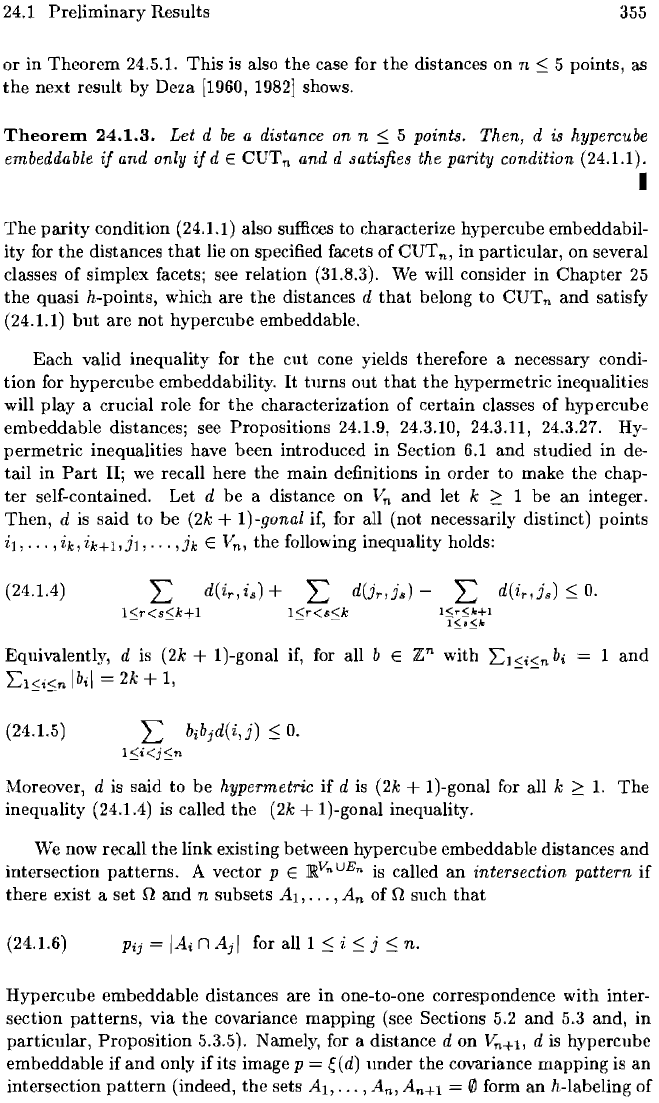
24.1 Preliminary Results
355
or
in
Theorem 24.5.1.
This
is also
the
case for
the
distances on n
::;
5 points, as
the
next result by Deza [1960,
1982]
shows.
Theorem
24.1.3.
Let
d
be
a distance on n
::;
5 points. Then, d is hypercube
embeddable
if
and
only
if
d E
CUT
nand
d satisfies the parity condition (24.1.1).
I
The
parity
condition (24.1.1) also suffices to characterize hypercube embeddabil-
ity for
the
distances
that
lie on specified facets of
CUT
n,
in particular, on several
classes
of
simplex facets; see relation (31.8.3).
We
will consider in
Chapter
25
the
quasi h-points, which are
the
distances d
that
belong to
CUTn
and
satisfy
(24.1.1)
but
are not hypercube embeddable.
Each valid inequality for the cut cone yields therefore a necessary condi-
tion
for hypercube embeddability.
It
turns out
that
the
hypermetric inequalities
will
playa
crucial role for
the
characterization
of
certain classes
of
hypercube
embeddable distances; see Propositions 24.1.9, 24.3.10, 24.3.11, 24.3.27. Hy-
permetric
inequalities have been introduced in Section
6.1
and studied in de-
tail in
Part
II;
we
recall here the main definitions
in
order to make
the
chap-
ter
self-contained. Let d be a distance on
Vn
and
let k
2:
1 be
an
integer.
Then,
d
is
said
to
be (2k +
l)-gonal
if,
for all (not necessarily distinct) points
iI,
...
, ik, ik+l,
jl
,
...
,jk
E V
n
,
the
following inequality holds:
(24.1.4)
Equivalently,
d is (2k + 1}-gonal if, for all b E
zn
with
"'-'Js,t:::,nb;
"'-'l<
••
<-n
Ibil
=
2k
+
1,
(24.1.5)
L
bibjd(i,j)::;
O.
lsi<jsn
1
and
Moreover, d is said to
be
hypermetric if d
is
(2k + 1 )-gonal for all k
2:
1.
The
inequality (24.1.4) is called
the
(2k + 1 )-gonal inequality.
We
now
recall
the
link existing between hypercube embeddable distances
and
intersection patterns. A vector p E
jRv"
UE"
is
called
an
intersection pattern
if
there exist a set n
and
n subsets
"41,
...
,An
of n such
that
(24.1.6)
Pij
IAi n
Aj
I for all 1
::;
i
::;
j
::;
n.
Hypercube embeddable distances are
in
one-to-one correspondence with inter-
section
patterns,
via
the
covariance mapping (see Sections 5.2
and
5.3 and,
in
particular, Proposition 5.3.5). Namely, for a distance
don
Vn+b d is hypercube
embeddable if
and
only
if
its image p =
~(d)
under the covariance mapping is
an
intersection
pattern
(indeed,
the
sets
AI'"''
An, An+l = 0 form
an
h-labeling
of
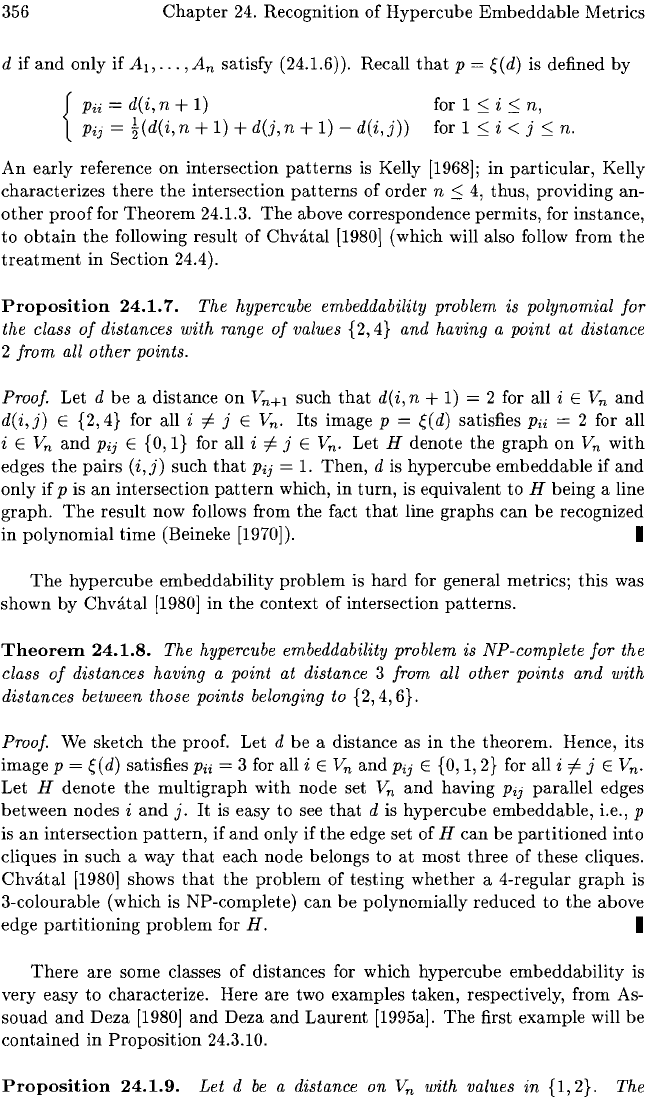
356
Chapter
24. Recognition of Hypercube
Embeddable
Metrics
d if
and
only if
AI,'
..
,An
satisfy (24.1.6)). Recall
that
p =
e(
d)
is defined by
{
Pii
=
d(i,n
+
1)
Pij =
~(d(i,
n + 1) +
d(j,
n + 1) -
d(i,j))
for 1
S;
i
S;
n,
for 1
S;
i < j
S;
n.
An
early reference
on
intersection
patterns
is
Kelly
[1968];
in
particular,
Kelly
characterizes
there
the
intersection
patterns
of order n
S;
4,
thus, providing an-
other
prooffor
Theorem
24.1.3.
The
above correspondence
permits,
for instance,
to
obtain
the
following result of
Chvatal
[1980]
(which will also follow from
the
treatment
in
Section 24.4).
Proposition
24.1.7.
The hypercube embeddability problem is polynomial
for
the class
of
distances with range
of
values
{2,
4}
and
having a
point
at distance
2
from
all
other
points.
Proof.
Let d
be
a distance
on
V
n
+
l
such
that
d(i, n +
1)
= 2 for all i E Vn
and
d(i,j)
E {2,4} for all i
oJ-
j E V
n
.
Its
image p =
e(d)
satisfies Pii = 2 for all
i E
Vn
and
Pij E
{O,
I} for all i
oJ-
j E V
n
. Let H denote
the
graph
on
Vn
with
edges
the
pairs
(i,j)
such
that
Pij =
1.
Then,
d is
hypercube
embeddable
if
and
only if p is
an
intersection
pattern
which,
in
turn,
is equivalent to H being a line
graph.
The
result now follows from
the
fact
that
line graphs
can
be recognized
in
polynomial
time
(Beineke [1970]). I
The
hypercube
embeddability
problem
is
hard
for general metrics;
this
was
shown by
Chvatal
[1980]
in
the
context of intersection
patterns.
Theorem
24.1.8.
The
hypercube embeddability problem is
NP-complete
for
the
class
of
distances having a
point
at distance 3 from all
other
points
and
with
distances between those points belonging to
{2,
4,
6}.
Proof.
We
sketch
the
proof. Let d be a distance as
in
the
theorem. Hence,
its
image p =
e(d)
satisfies Pii = 3 for all i E Vn
and
Pij E
{O,
I,
2}
for all i
oJ-
j E V
n
.
Let H denote
the
multigraph
with
node set
Vn
and
having Pij parallel edges
between nodes
i
and
j.
It
is
easy to see
that
d is
hypercube
embeddable, i.e., P
is
an
intersection
pattern,
if
and
only if
the
edge set
of
H
can
be
partitioned
into
cliques
in
such a way
that
each node belongs to
at
most
three
of these cliques.
Chvatal
[1980]
shows
that
the
problem of testing whether a 4-regular
graph
is
3-colourable (which
is
NP-complete)
can
be
polynomially reduced to
the
above
edge
partitioning
problem for H. I
There
are some classes of distances for which hypercube
embeddability
is
very easy to characterize. Here are two examples taken, respectively, from As-
souad
and
Deza
[1980]
and
Deza
and
Laurent
[1995a].
The
first example will be
contained
in
Proposition
24.3.10.
Proposition
24.1.9.
Let
d
be
a distance
on
Vn
with values
in
{1,2}. The
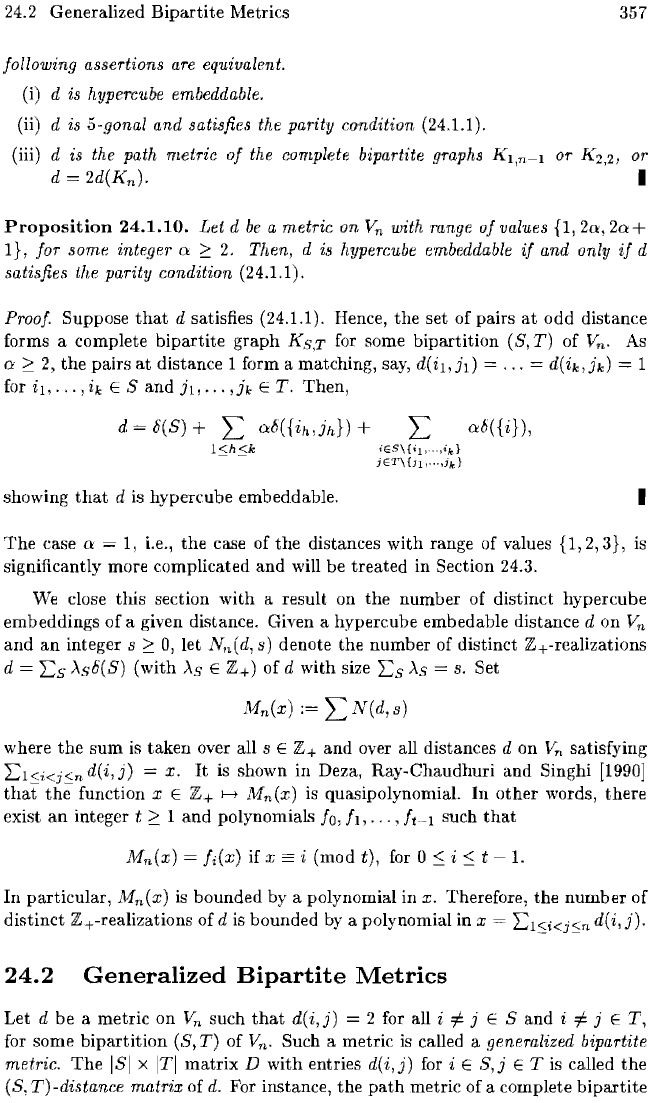
24.2 Generalized
Bipartite
Metrics
following assertions are equivalent.
(i)
d is hypercube embeddable.
(ii) d is 5-gonal
and
satisfies the parity condition (24.1.1).
357
(iii) d is the path
metric
of
the complete bipartite graphs
Kl,n~l
or Kz,z,
or
d =
2d(K
n
}.
I
Proposition
24.1.10.
Let
d
be
a
metric
on
Vn
with range
of
values {1,
20:,
20:+
1},
for
some
integer 0: ;::
2.
Then, d is hypercube embeddable
if
and
only
if
d
satisfies the parity condition
(24.1.1).
Proof. Suppose
that
d satisfies (24.1.1). Hence,
the
set
of
pairs
at
odd
distance
forms a complete
bipartite
graph
KS,T
for some
bipartition
(S,
T)
of V
n
.
As
0:
;::
2,
the
pairs
at
distance 1 form a matching, say,
d(i1,h)
=
...
=
d(ik,jk)
= 1
for
i1,""
ik
E
Sand
j1,'"
,jk
E
T.
Then,
d
O(S)
+
showing
that
d is
hypercube
embeddable.
iES\{il)···)ik}
jET\{}j,·
..
,h}
o:o({i}),
I
'The case
0:
1,
the
case
of
the
distances
with
range of values {1,
2,
3}, is
significantly more complicated
and
will be
treated
in Section 24.3.
We close
this
section
with
a result on
the
number
of distinct
hypercube
errlbE;(1dlml~S
of
a given distance. Given a
hypercube
embed
able distance d
on
Vn
and
an
integer s
2:
0,
let N
n
(
d,
s) denote
the
number
of
distinct
Z+-realizations
d
Aso(S)
(with
As
E
Z+)
of
d
with
size
Ls
As
=
s.
Set
where
the
sum
is
taken
over all s E
Z+
and
over all distances
don
Vn
satisfying
L1S,i<js,nd(i,j)
=
x.
It
is shown
in
Deza,
Ray-Chaudhuri
and
Singhi
[1990]
that
the
function x E
Z+
f-t
Afn(x}
is quasipolynomial.
In
other
words,
there
exist
an
integer t
;::
1
and
polynomial., fo,
II,
... ,
ft-1
such
that
Mn(X) = f;(x)
if.1:
==
i (mod t), for 0:-; i:-; t 1.
In
particular,
Mn(x)
is
bounded
by a polynomial
in
x. Therefore,
the
number
of
distinct
Z+-realizations of d
is
bounded
by a polynomial in x
d(i,j).
24.2
Generalized
Bipartite
Metrics
Let
d be a
metric
on
Vn
such
that
d(i,j)
= 2 for all i
:j:.
j E
Sand
i
:j:.
j
for some
bipartition
(S,
T)
of
V
n
.
Such a metric
is
called a generalized bipartite
metric.
The
lSI
x
ITI
matrix
D
with
entries
d(i,j)
for i E
S,j
E T is called
the
(S,
T)-distance
matrix
of
d.
For instance,
the
path
metric of a complete
bipartite
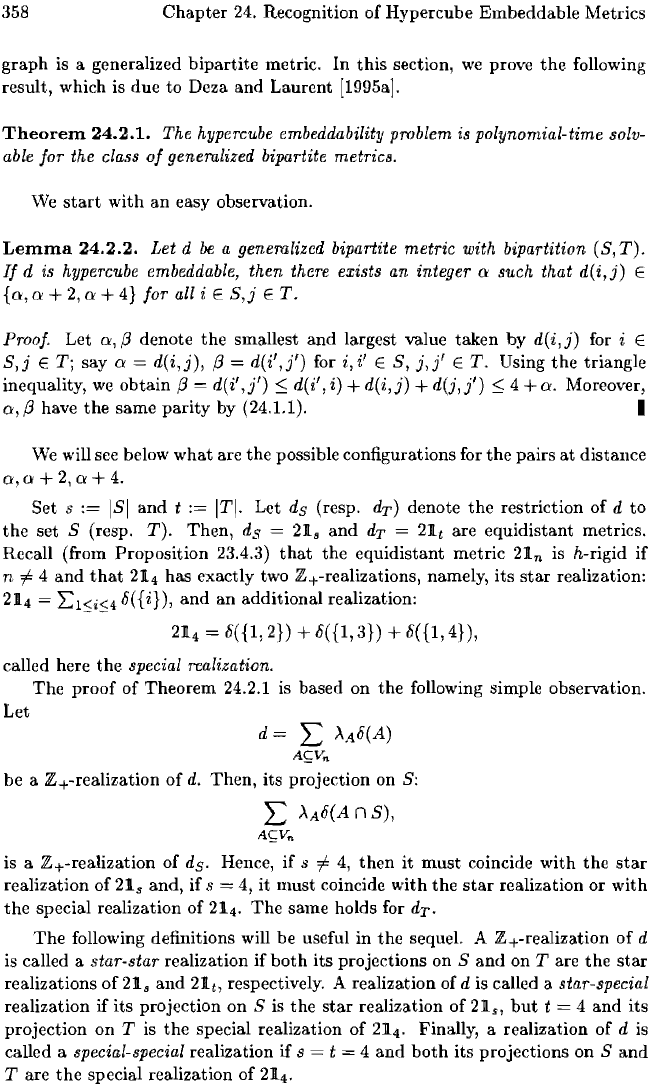
358
Chapter
24.
Recognition of Hypercube Embeddable Metrics
graph
is a generalized bipartite metric.
In
this
section,
we
prove
the
following
result, which is due
to
Deza and Laurent
[1995aJ.
Theorem
24.2.1.
The hypercube embeddability problem is polynomial-time solv-
able for the class
of
generalized bipartite metrics.
We
start
with
an
easy observation.
Lemma
24.2.2.
Let
d
be
a generalized bipartite metric with bipartition (8,
T).
If
d is hypercube embeddable, then there exists an integer
0'
such that
d(i,j)
E
{O',o'
+ 2,0' +
4}
for all i E
8,j
E
T.
Proof. Let
0',
(3
denote the smallest and largest value taken by
d(i,j)
for i E
8,j
E say
0'
d(i,j),
(3
dW,i')
for
i,i'
E
8,
i,j'
E
T.
Using
the
triangle
inequality,
we
obtain
(3
d(
i',
j')
:::;
d(
i', i) +
d(
i,
i)
+
d(j,j')
~
4 +
0'.
Moreover,
0',
(3
have the same parity by (24.1.1). I
We
will see below what are the possible configurations for the pairs
at
distance
0',0'
+ 2,0' +
4.
Set s
:=
181
and t
:=
ITI.
Let
ds
(resp. d
T
) denote the restriction of d to
the
set 8 (resp.
T).
Then,
ds
=
21.
and
dT
= 21t are equidistant metrics.
Recall (from Proposition 23.4.3)
that
the equidistant metric 21n is h-rigid if
n
'"
4
and
that
214 has exactly two Z+-realizations, namely, its
star
realization:
214
D(
{i}),
and
an
additional realization:
214
=
6(
{I,
2}) +
D(
{I,
3}) + D({I, 4}),
called here
the
special realization.
The
proof
of
Theorem 24.2.1 is based on
the
following simple observation.
Let
be a Z+-realization
of
d.
Then,
its projection on
8:
L
>'AD(A
n 8),
A<;;;V"
is a Z+-realization
of
ds. Hence,
if
8
'"
4,
then
it
must
coincide
with
the
star
realization of 218 and, if s = 4,
it
must coincide
with
the
star
realization or with
the
special realization of 21
4
•
The
same holds for d
T
•
The
following definitions will be useful in
the
sequel. A Z+-realization
of
d
is called a star-star realization
if
both
its
projections on 8
and
on T are
the
star
realizations
of
21.
and
21t,
respectively. A realization of d is called a star-special
realization if its projection on 8 is the
star
realization of
21.,
but
t 4
and
its
projection on T is the special realization
of
214' Finally, a realization
of
d is
called a
special-special realization if s t 4
and
both
its projections on 8 and
T are
the
special realization
of
214.
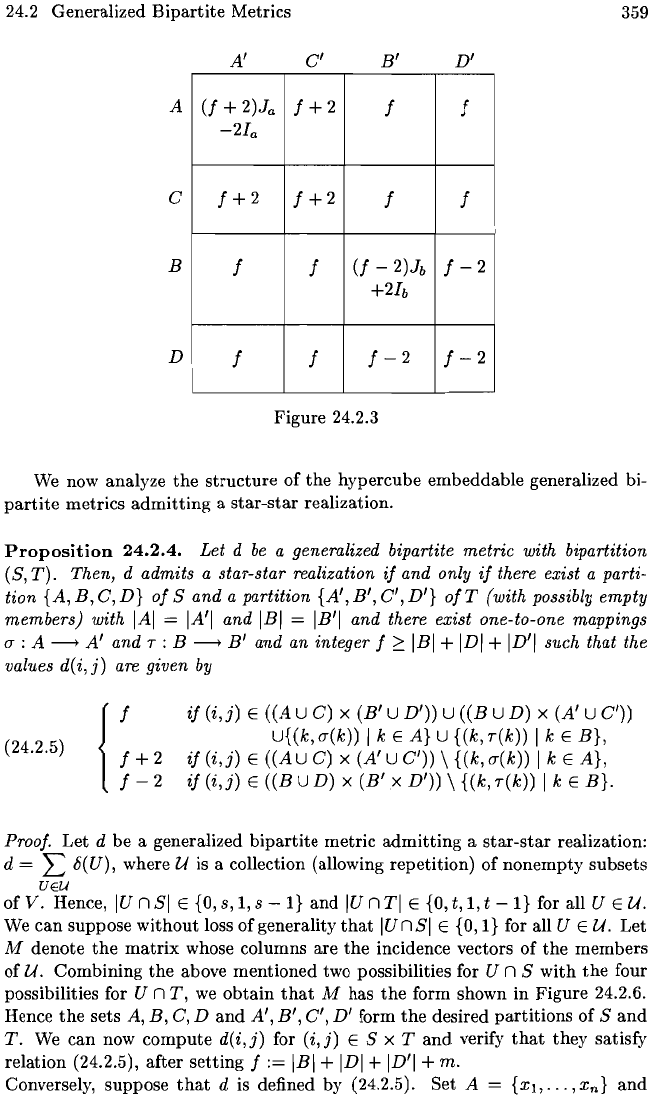
24.2 Generalized
Bipartite
Metrics
359
A'
G'
B'
D'
A
(f
+
2)J
a
f+2
f f
-
2I
a
G
f+2 f+2
f f
B f
f
(f
- 2)Jb
f-2
+2Ib
D
f f
f-2
f-2
Figure 24.2.3
We now analyze
the
structure
of
the
hypercube
embeddable
generalized bi-
partite
metrics
admitting
a
star-star
realization.
Proposition
24.2.4.
Let
d
be
a generalized bipartite
metric
with bipartition
(5,
T).
Then, d
admits
a
star-star
realization
if
and
only
if
there exist a parti-
tion
{A,
B,
G,
D}
of
5
and
a partition
{A',
B',
G',
D'}
ofT
(with possibly
empty
members)
with
IAI
=
IA'I
and
IBI
=
IB'I
and
there exist one-to-one mappings
(T
: A
---+
A'
and
r : B
---+
B'
and an integer f
2:
IBI
+
IDI
+
ID'I
such
that
the
values
d(i,j)
are given by
(24.2.5)
if
(i,j)
E
((A
U
G)
x
(B'
U
D'))
U
((B
U
D)
x
(A'
U
G'))
U{(k,(T(k)) IkE
A}
U
{(k,r(k))
IkE
B},
if
(i,j)
E
((A
U
G)
x
(A'
U
G'))
\
{(k,
(T(k)) IkE
A},
if
(i,j)
E
((B
UD)
x
(B'
x
D'))
\
{(k,r(k))
IkE
B}.
Proof.
Let
d be a generalized
bipartite
metric
admitting
a
star-star
realization:
d = L 8(U), where U
is
a collection (allowing repetition)
of
nonempty
subsets
UEU
of
V.
Hence,
IU
n
51
E
{a,
s,
1,
s -
I}
and
IU
n
TI
E
{a,
t, 1, t -
I}
for all U E U.
We
can
suppose
without
loss
of
generality
that
lun51
E
{a,
I}
for all U E U. Let
M
denote
the
matrix
whose columns are
the
incidence vectors
of
the
members
of
U. Combining
the
above
mentioned
two possibilities for
Un
5
with
the
four
possibilities for
Un
T,
we
obtain
that
M has
the
form shown in
Figure
24.2.6.
Hence
the
sets A,
B,
G,
D
and
A',
B',
G',
D'
form
the
desired
partitions
of
5
and
T.
We
can
now
compute
d(i,j)
for
(i,j)
E 5 x T
and
verify
that
they
satisfy
relation
(24.2.5),
after
setting
f
:=
IBI
+
IDI
+
ID'I
+
m.
Conversely, suppose
that
d is defined by (24.2.5). Set A = {Xl,
...
,x
n
}
and
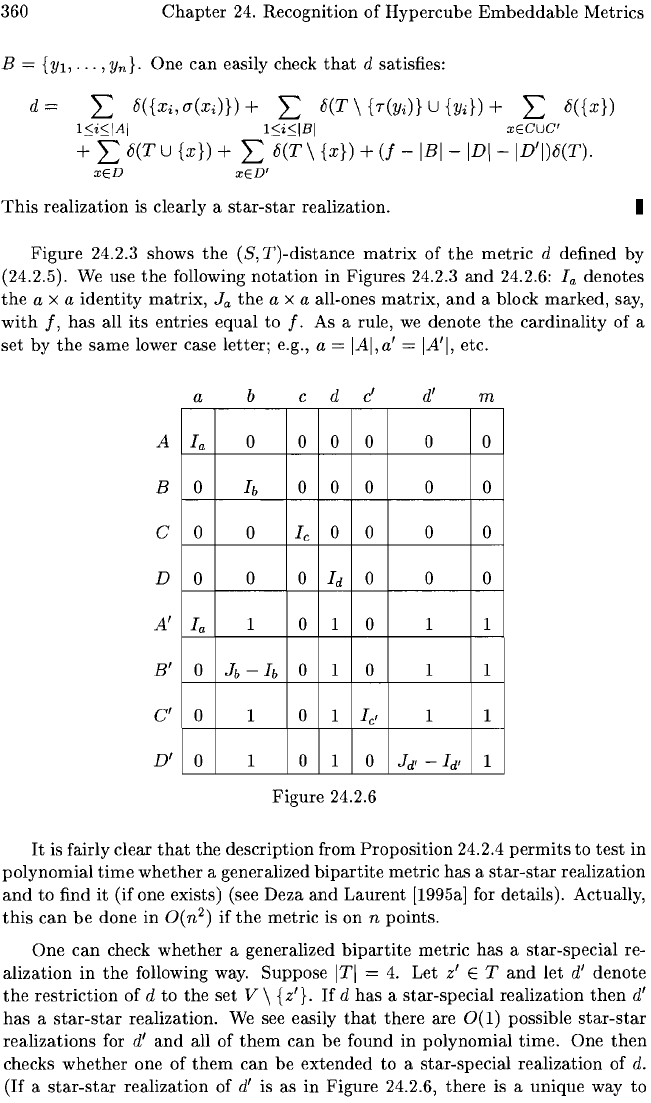
360
Chapter
24.
Recognition
of
Hypercube
Embeddable
Metrics
B =
{Yb
...
,Yn}'
One
can
easily check
that
d satisfies:
d = L 8({Xi,0'(Xi)}) + L 8(T \ {r(Yi)} U
{yd)
+ L 8({x})
l~i~IAI l~i~IBI
xECUC'
+ L
8(TU
{x})
+ L
8(T\
{x})
+U
-IBI-IDI-ID'I)8(T).
xED'
This
realization
is
clearly a
star-star
realization.
I
Figure
24.2.3 shows
the
(8,
T)-distance
matrix
of
the
metric
d defined by
(24.2.5). We use
the
following
notation
in Figures 24.2.3
and
24.2.6:
Ia
denotes
the
a x a identity
matrix,
J
a
the
a x a all-ones
matrix,
and
a block marked, say,
with
f,
has
all
its
entries equal to f. As a rule,
we
denote
the
cardinality of a
set
by
the
same
lower case letter; e.g., a =
IAI,a'
= IA'I, etc.
a
b
cdc'
d'
m
A
Ia
0 0 0 0
0
0
B 0
h
0 0 0 0 0
C 0
0
Ie
0 0 0 0
D
0
0 0
Id
0 0 0
A'
Ia
1
0
1
0
1 1
B'
0
Jb
-h
0
1
0
1 1
C'
0 1 0 1
Ie'
1 1
D'
0
1 0 1
0
J
d
, - I
d
,
1
Figure
24.2.6
It
is fairly clear
that
the
description from
Proposition
24.2.4
permits
to
test
in
polynomial
time
whether
a generalized
bipartite
metric has a
star-star
realization
and
to find
it
(if one exists) (see Deza
and
Laurent
[1995a] for details). Actually,
this
can
be
done in
0(n
2
)
if
the
metric is on n points.
One
can
check
whether
a generalized
bipartite
metric has a star-special re-
alization in
the
following way. Suppose
ITI
=
4.
Let z' E T
and
let d'
denote
the
restriction
of d to
the
set V \
{z'}.
If
d
has
a star-special realization
then
d'
has
a
star-star
realization. We see easily
that
there
are
0(1)
possible
star-star
realizations for d'
and
all of
them
can
be
found in polynomial time.
One
then
checks
whether
one
of
them
can
be
extended to a star-special realization of
d.
(If
a
star-star
realization of
d'
is as in
Figure
24.2.6,
there
is a
unique
way to
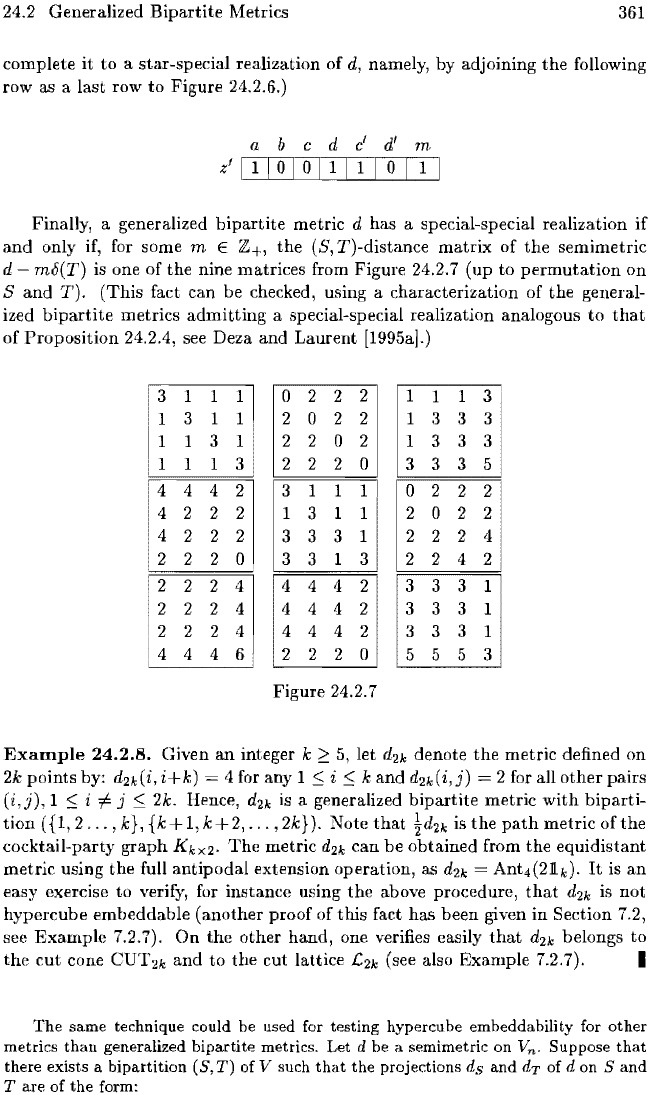
24.2
Generalized
Bipartite
Metrics
361
complete
it
to
a star-special realization
of
d,
namely, by adjoining the following
row as a
last
row
to
Figure
24.2,6,)
Finally, a generalized
bipartite
metric d has a special-special realization if
and
only if, for some m E Z+, the (5, T)-distance
matrix
of
the
semimetric
d -
mli(T)
is one
of
the nine matrices from Figure
24.2.7
(up to
permutation
on
5
and
T). (This fact can
be
checked, using a characterization
of
the
general-
ized
bipartite
metrics
admitting
a special-special realization analogous
to
that
of
Proposition
24,2.4, see Deza and Laurent [1995aJ.)
3 1 1 1
1 3 1 1
1
131
1 1 1 3
444
2
422
2
4 2 2 2
2 2 2 0
2
224
2
224
2 2 2 4
0
2 2
2
2 0 2 2
2
2 0 2
2
2 2 0
3 1
1 1
1
3
1 1
3 3 3
1
3 3
1 3
4 4 4 2
4 4 4 2
4 4 4 2
2 2 2
0
Figure
24.2,7
1
1
1 3
1 3 3
3
1 3 3 3
3 3 3 5
0 2 2 2
2 0 2 2
2 2 2 4
2 2 4 2
3 3 3 1
3 3 3 1
3 3 3
1
5 5 5
3
Example
24.2.8.
Given
an
integer k
;:::
5, let d
2
k
denote
the
metric defined
on
2k
points
by: d2k(i,
i+k)
4 for any 1
SiS
k
and
d
2
k(i,j)
= 2 for all
other
pairs
(i,j),1
S i
i=
j S 2k. Hence, d
2
k
is a generalized
bipartite
metric
with
biparti-
tion
(
{I,
2
...
, k},
1,
k +
2,
...
, 2k}). Note
that
td2k is
the
path
metric of
the
cocktail-party
graph
Kkx2.
The
metric
d2l,
can
be
obtained
from the
equidistant
metric using
the
full
antipodal
extension operation, as
d2k
= Ant4(21k),
It
is
an
easy exercise
to
verify, for instance using
the
above procedure,
that
d
2k
is
not
hypercube
embeddable
(another
proof
of
this fact has been given
in
Section 7,2,
see
Example
7.2.7).
On
the
other
hand, one verifies easily
that
d
2
k
belongs to
the
cut
cone CUT2k
and
to
the
cut lattice
£.2k
(see also Example 7.2.7). I
The
same
technique could be used for testing hypercube embeddability for
other
metrics
than
generalized
bipartite
metrics. Let d be a semimetric
on
V
n
.
Suppose
that
there
exists a
bipartition
(S,
T)
of
V such
that
the
projections d
s
and
d
T
of
d
on
Sand
T
are
of
the
form:
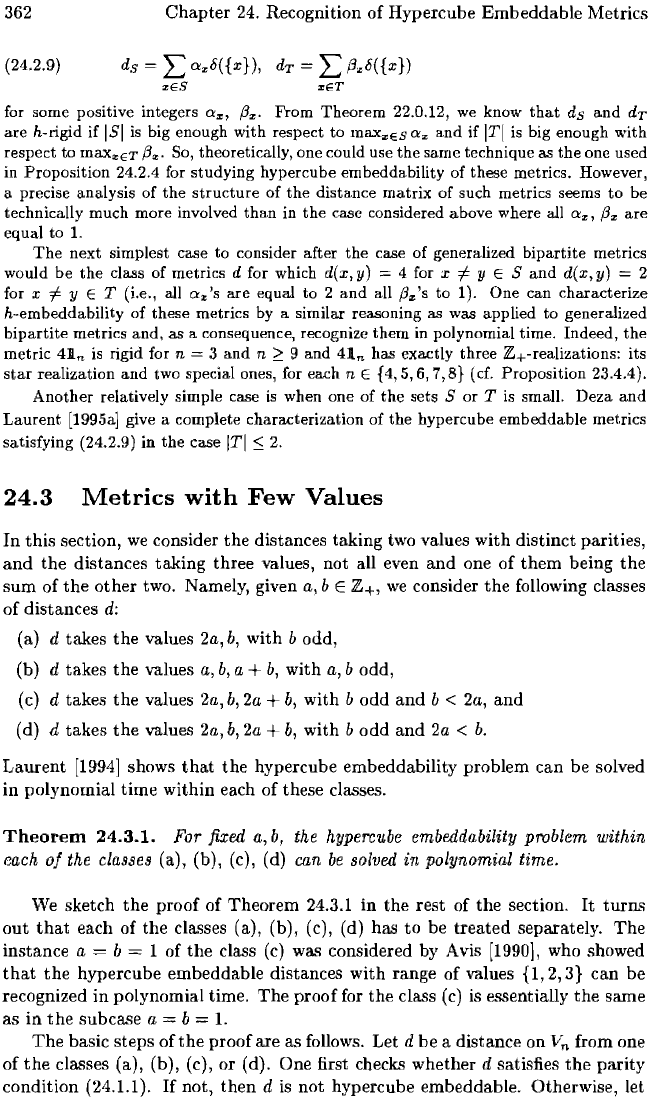
362
Chapter
24.
Recognition
of
Hypercube Embeddable Metrics
(24.2.9)
"ES
.,ET
for some positive integers
a."
(3".
From
Theorem
22.0.12, we know
that
ds
and
dT
are
h-rigid
if
lSI
is
big enough with respect
to
ma.x"ES
a",
and
if
ITI
is big enough with
respect
to
ma.x"'ET
(3",.
So, theoretically, one could use
the
same technique
as
the
one used
in
Proposition
24.2.4 for
studying
hypercube embeddability
of
these metrics. However,
a precise analysis
of
the
structure
of
the
distance
matrix
of
such metrics seems
to
be
technically much more involved
than
in
the
case considered above where all
a""
(3"
are
equal
to
1-
The
next
simplest case
to
consider after
the
case
of
generalized
bipartite
metrics
would
be
the
class
of
metrics d for which
d(x,y)
4 for x #
yES
and
d(x,y)
= 2
for
x #
yET
(i.e., all
a,,'s
are
equal
to
2
and
all
(3,,'s
to
1).
One
can characterize
h-embeddability
of
these metrics by a similar reasoning as was applied
to
generalized
bipartite
metrics
and,
as
a consequence, recognize
them
in polynomial time. Indeed,
the
metric
41
n
is rigid for n 3
and
n
2:
9 and
41n
has exactly three Z+-realizations: its
star
realization
and
two special ones, for each n E
{4,5,6,
7,8}
(d.
Proposition 23.4.4).
Another
relatively simple case
is
when
one
of
the
sets S
or
T is small.
Deza
and
Laurent
[1995a] give a complete characterization
of
the
hypercube embeddable metrics
satisfying (24.2.9)
in
the
case
ITI
::;
2.
24.3
Metrics
with
Few
Values
In
this section,
we
consider the distances taking two values with distinct parities,
and the distances taking three values, not all even and one
of
them
being
the
sum of
the
other two. Namely, given
a,
bE
Z+,
we
consider the following classes
of
distances
d:
(a) d takes
the
values
2a,
b,
with b odd,
(b)
d takes
the
values
a,
b,
a +
b,
with
a,
b odd,
(c)
d takes
the
values
2a,
b,
2a
+
b,
with b odd and b <
2a,
and
(d)
d takes
the
values
2a,
b,
2a
+
b,
with b odd and
2a
<
b.
Laurent
[1994]
shows
that
the hypercube embeddability problem can be solved
in polynomial time within each
of
these classes.
Theorem
24.3.1.
For fixed
a,
b,
the hypercube embeddability problem within
each
of
the classes (a), (b), (c), (d)
can
be
solved in polynomial time.
We
sketch
the
proof
of
Theorem 24.3.1 in the rest of the section.
It
turns
out
that
each
of
the classes (a), (b), (c), (d) has
to
be treated separately.
The
instance a b = 1 of
the
class (c) was considered by Avis [1990j, who showed
that
the
hypercube embeddable distances with range of
,,-alues
{I,
2,
3}
can be
recognized in polynomial time. The prooffor the class (c) is essentially
the
same
as in
the
subcase a = b = L
The basic steps
of
the
proof are as follows. Let d be a distance on Vn from one
of
the
classes (a), (b), (c), or (d). One first checks whether d satisfies
the
parity
condition (24.1.1).
If
not, then d
is
not hypercube embeddable. Otherwise, let
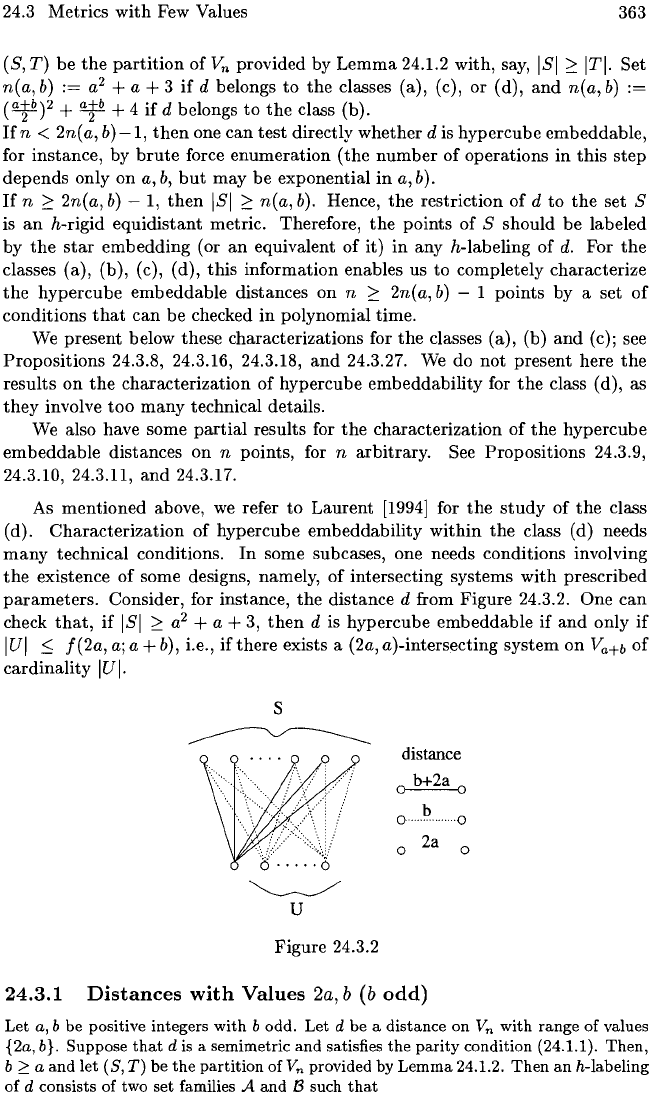
24.3 Metrics
with
Few Values
363
(S,
T)
be
the
partition
of
Vn
provided
by
Lemma
24.1.2
with,
say,
lSI
2:
ITI.
Set
n(a,
b)
:=
a
2
+ a + 3
if
d belongs
to
the
classes (a), (c),
or
(d),
and
n(a,
b)
:=
(~?
+
~
+ 4
if
d belongs
to
the
class (b).
Ifn
<
2n(a,
b)-I,
then
one
can
test
directly
whether
d is
hypercube
embeddable,
for
instance,
by
brute
force
enumeration
(the
number
of
operations
in
this
step
depends
only
on
a,
b,
but
may
be
exponential
in
a,
b).
If
n
2:
2n(a,
b)
- 1,
then
lSI
2:
n(a,
b).
Hence,
the
restriction
of
d
to
the
set S
is
an
h-rigid
equidistant
metric. Therefore,
the
points
of
S
should
be
labeled
by
the
star
embedding
(or
an
equivalent
of
it)
in
any
h-Iabeling
of
d.
For
the
classes (a), (b), (c), (d),
this
information
enables us
to
completely characterize
the
hypercube
embeddable
distances
on
n
2:
2n(a,
b)
- 1
points
by
a set
of
conditions
that
can
be
checked
in
polynomial
time.
We
present
below these characterizations for
the
classes (a), (b)
and
(c); see
Propositions
24.3.8, 24.3.16, 24.3.18,
and
24.3.27. We
do
not
present
here
the
results
on
the
characterization
of
hypercube
embeddability
for
the
class (d), as
they
involve
too
many
technical details.
We also have some
partial
results for
the
characterization
of
the
hypercube
embeddable
distances
on
n points, for n
arbitrary.
See
Propositions
24.3.9,
24.3.10, 24.3.11,
and
24.3.17.
As
mentioned
above, we refer
to
Laurent
[1994]
for
the
study
of
the
class
(d).
Characterization
of
hypercube
embeddability
within
the
class (d) needs
many
technical conditions.
In
some subcases, one needs conditions involving
the
existence
of
some designs, namely,
of
intersecting
systems
with
prescribed
parameters.
Consider, for instance,
the
distance
d from
Figure
24.3.2.
One
can
check
that,
if
lSI
2:
a
2
+ a + 3,
then
d is
hypercube
embeddable
if
and
only
if
lUI
.::;
f(2a,
a;
a + b), i.e.,
if
there
exists a (2a, a)-intersecting
system
on
Va+b
of
cardinality
lUI.
s
~
~
U
Figure
24.3.2
distance
~
0
..
b
.....
0
o 2a
o
24.3.1
Distances
with
Values
2a, b
(b
odd)
Let
a, b
be
positive integers
with
b
odd.
Let
d
be
a
distance
on
Vn
with
range
of
values
{2a,
b}.
Suppose
that
d is a semimetric
and
satisfies
the
parity
condition
(24.1.1).
Then,
b
2:
a
and
let
(S,
T)
be
the
partition
of
Vn
provided by
Lemma
24.1.2.
Then
an
h-Iabeling
of
d consists of two
set
families A
and
B such
that
